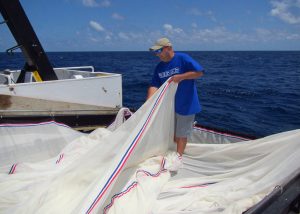Study Develops Biogeographic Classification of the World’s Deep Oceans
– SEPTEMBER 19, 2017
A global biogeographic classification of the mesopelagic zone.Mesopelagic organisms provide important ecosystem services such as carbon cycling but are also vulnerable to issues such as climate change and deoxygenation. Our limited knowledge of these ecosystems is increasingly problematic as acidification, commercial fishing, seabed mining, and other environmental threats increase. The spatially patchy and inconsistent manner of pelagic data collection (less than 1% of this habitat has been sampled) have hampered researchers’ ability to conduct quantitative analyses of pelagic taxonomy and environment. This study’s team begins to address this data void by using an integrated approach since global information gaps and sampling methods preclude strictly statistical approaches.
Employing a modified Delphi Method during a July 2013 workshop, the team defined water mass boundaries according to temperature, salinity, and dissolved oxygen, which are some of the strongest factors driving biogeographical ecoregions. The experts organized 33 ecoregions across four oceanic biomes into 3 polar ecoregions, 10 westerly winds ecoregions, 7 trade wind ecoregions (which includes the Gulf of Mexico), and 13 distant neritic ecoregions (where sunlight reaches the ocean floor) based on large-scale commonalities. Those commonalities included known species, physical oceanography (major currents and water masses), dissolved oxygen concentrations, temperature extremes, and the amount of life in overlying waters (surface to 200 meters depth).
“The Gulf’s mesopelagic zone was the largest ecosystem affected by the Deepwater Horizon oil spill,” explained author Tracey Sutton. “What most do not realize is that its deep waters are also highly diverse. The animals that live at these depths differ radically from those in coastal waters and most undertake extensive daily migrations from great depths (daytime) to surface waters (nighttime).” Sutton said that scientists from the DEEPEND research consortium have identified nearly 800 offshore fish species, of which 180 were previously unknown to live there. “These data were used in a recently published international effort to “map” the mesopelagic zone of the global ocean. Such maps are critical for global conservation and management efforts, especially as human resource extraction and its associated impact go deeper and deeper.”
Sutton said that studies such as these provide increasing evidence that the deep sea is far from a ‘biological desert,’ as previously thought, and that new discoveries are likely with continued research.
Data are publicly available through the Gulf of Mexico Research Initiative Information & Data Cooperative (GRIIDC) at 10.7266/N7VX0DK2.
The study’s authors are Tracey T. Sutton, Malcolm R. Clark, Daniel C. Dunn, Patrick N. Halpin, Alex D. Rogers, John Guinotte, Steven J. Bograd, Martin V. Angel, Jose Angel A. Perez, Karen Wishner, Richard L. Haedrich, Dhugal J. Lindsay, Jeffrey C. Drazen, Alexander Vereshchaka, Uwe Piatkowski, Telmo Morato, Katarzyna Blachowiak-Samolyk, Bruce H. Robison, Kristina M. Gjerde, Annelies Pierrot-Bults, Patricio Bernal, Gabriel Reygondeau, and Mikko Heino.
************
This research was made possible in part by a grant from the Gulf of Mexico Research Initiative (GoMRI) to the Deep-Pelagic Nekton Dynamics of the Gulf of Mexico (DEEPEND) consortium. Other funding sources included The Lenfest Ocean Program, the NF-UBC Nereus Programme, and the NIWA Vulnerable Deep-Sea Communities Project (Contract CO1X0906).
The Gulf of Mexico Research Initiative (GoMRI) is a 10-year independent research program established to study the effect, and the potential associated impact, of hydrocarbon releases on the environment and public health, as well as to develop improved spill mitigation, oil detection, characterization and remediation technologies. An independent and academic 20-member Research Board makes the funding and research direction decisions to ensure the intellectual quality, effectiveness and academic independence of the GoMRI research. All research data, findings and publications will be made publicly available. The program was established through a $500 million financial commitment from BP. For more information, visit https://gulfresearchinitiative.org/.
© Copyright 2010-2017 Gulf of Mexico Research Initiative (GoMRI) – All Rights Reserved. Redistribution is encouraged with acknowledgement to the Gulf of Mexico Research Initiative (GoMRI). Please credit images and/or videos as done in each article. Questions? Contact web-content editor Nilde “Maggie” Dannreuther, Northern Gulf Institute, Mississippi State University (maggied@ngi.msstate.edu).






